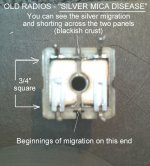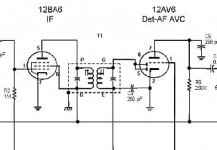The whole thing is heavy and big enough to not be worth the effort to ship.
Biotracers listed "for parts or not working" on Ebay go for at least 150 plus shipping. One seller is parting one out, has about 20 listings. He's asking 40 bucks for one of the feet, 4 watchers. He might not get what he is asking, but add up all of the listings and you get 800 bucks. He did not list the tone arm or its associated motors.
I am tempted to buy a dead biotracer and part it out if I can't make it run. Working units go for 500 or so.
I recently sold a Vintage PNY Nvidia Geforce 4 Ti4600 128MB AGP 4X video card for 112 bucks. It was working when pulled, but I couldn't guarantee it still does. Promised it would not be DOA, free return. He has received it, no complaints. I think folks are collecting them, don't care if they work. This one was in very good cosmetic shape.
Lubrication, rubber, dries out and turns to crap, cartridge cantilever suspensions dry up and get hard, all sorts of jolly good things happen after years in attics.
True, not the best environment. I have been amazed at how old gear can be restored in many cases. At the surplus store, we got this old machine that would make records. Came with blank glass disks coated in plastic. Sharp diamond stylus in a rubber suspension, dried out rock hard. I chiseled it out with a sewing needle, and put silicone rubber in it's place. Worked like new.
Funny story about an old table top AM radio: Guy brings it in, says it was working but the signal was weak. He tried to adjust the IF transformer but it was stuck. WD40 to the rescue! He sprayed it in, and the slug turned easily, but he couldn't get a peep out of the radio. Now, I go to work on it, thoughts of how foolish and ignorant he was. Of course the capacitance of the trimmer cap was altered by the oil. So, I fire up the air compressor, give it a squirt to remove the oil, and all the mica in the trimmer shot out in a cloud. Ha, now I was the foolish one. I disassembled the other IF, measured the thickness of the mica sheets, and split some mica we had in the store, cut it to size and installed them in. Tweaked the trimmer and the radio played loud and clear.
I know the Biotracers go for a surprising amount even as parts (I cannot for the life of me figure out why), but best I can tell the market is pretty well saturated with parted out PS-X75s. The one one part that the market isn't saturated with is the one that mine doesn't have- a working microprocessor. Maybe people want the parts for scratch-built turntables (I assume that's a thing).
Doesn't really matter that much anyway, the time it would take me to deal with it is time I don't have at the moment. I'd rather deal with priority #1 rather than priority #655. This particular PS-X75 isn't in pristine condition anyway. It failed sometime in the 1990s, a repair was attempted, it was partially reassembled and was stored in someone else's unheated attic until I got it.
It does horrify me to see what some people think they can keep in a barn or warehouse. I just cannot figure out what must go through someone's head when they decide to park a 24-track or a Harrison mixing console in a barn for the birds to crap on.
Doesn't really matter that much anyway, the time it would take me to deal with it is time I don't have at the moment. I'd rather deal with priority #1 rather than priority #655. This particular PS-X75 isn't in pristine condition anyway. It failed sometime in the 1990s, a repair was attempted, it was partially reassembled and was stored in someone else's unheated attic until I got it.
It does horrify me to see what some people think they can keep in a barn or warehouse. I just cannot figure out what must go through someone's head when they decide to park a 24-track or a Harrison mixing console in a barn for the birds to crap on.
Funny story about an old table top AM radio: Guy brings it in, says it was working but the signal was weak. He tried to adjust the IF transformer but it was stuck. WD40 to the rescue!
Now, I go to work on it, thoughts of how foolish and ignorant he was. I disassembled the other IF, measured the thickness of the mica sheets, and split some mica we had in the store, cut it to size and installed them in. Tweaked the trimmer and the radio played loud and clear.
As a seasoned restorer of many vintage products, let me give you some helpful advice on that particular subject....
Many old American tube type AM radios, mostly from the 1950's to 1960's, used Miller brand IF transformers. (about 3/4 inch square, 2 inches tall)
These are also found in tube type HIFI tuners too.
The mica insulator in the base, usually riveted between the metal vanes, gets nasty - meaning that the silver conducting coating on the mica leaches across the mica causing a short circuit. (black conductive areas on the mica from arcing)
This leads to AM reception prone to noisy operation, sounds like a thunderstorm, crackling, sputtering in the audio.
The best solution in that case is to remove the mica sheet, (a Dremel helps to remove the rivet) lift the metal vanes apart to keep them seperate, then add a pair of silver mica caps of around 100 to 200 pF, 500V under the chassis, on the appropriate pins of the transformer.
Note, this is a very delicate job, requiring steady hands, magnification, good lighting, and some time, since you're working with extremely tiny wires, hair-thin, from the IF coils.
In some cases, disconnecting the coils is needed, but mark the wires orientation with a sharpie marker (1,2,3,4 dots)
A bit of AM alignment is required afterwards, but reception will be noise-free.
Lord knows, I've done enough of these through the decades for customers who prized their old radios and wanted to hang onto them for sentimental reasons.
And it commands a higher restoration price as well.
Last edited:
I just cannot figure out what must go through someone's head when they decide to park a 24-track or a Harrison mixing console in a barn for the birds to crap on.
You should see what barn storage does to a Wurlitzer 1015 bubbler. Worst thing is the plastics. Those translucent pieces in front of the color cylinders etc. The heat just about melts them. Aftermarket parts are available for 600 a set. Recently sold a set we had to a guy in Belgium.
Personally given the plastics tech of the time It's impressive ANY of it survives 65 years on those old jukeboxes.
Then there is "novel technology" waiting in the wings for turntables...Just what type of psycho-babble awaits us for "The Ultimate" turntable. Imagine if you will some "Our turntable uses an oriented null quantum cryogenic treated crystalline tonearm.
There will be the crazy, "Wood for the tonearm is Dalbergia, harvested from India near the Goromara National Park"....blah, blah, blah...
----------------------------------------------------------------------Rick....
There will be the crazy, "Wood for the tonearm is Dalbergia, harvested from India near the Goromara National Park"....blah, blah, blah...
----------------------------------------------------------------------Rick....
Attachments
And special music was played to the trees while they were growing, with conductive fertilizer made from the ashes of jazz musicians. Sonically tuned tube worms included for an extra fee."Wood for the tonearm is Dalbergia, harvested from India near the Goromara National Park"....blah, blah, blah...
The mica insulator in the base, usually riveted between the metal vanes, gets nasty - meaning that the silver conducting coating on the mica leaches across the mica causing a short circuit. (black conductive areas on the mica from arcing)
Not understanding the configuration. Is this mica base a capacitor? Metal vanes? How does the silver move? No way to remove or dissolve the migrated silver? I have no doubt any lack of understanding is on me. You know what you are talking about, so I anxiously await whatever it takes to get through my thick head. 🙄
Not understanding the configuration. Is this mica base a capacitor? Metal vanes? How does the silver move? No way to remove or dissolve the migrated silver? I have no doubt any lack of understanding is on me. You know what you are talking about, so I anxiously await whatever it takes to get through my thick head. 🙄
The silver coating on the mica is just a thin vaproized layer, and no, it doesn't move, however it does leach across the mica over time, due to the electrical B+ through the coil (plate side of tube).
This leakage eventually causes noisy reception, static, etc, and is common for those types of IF cans.
The metal vanes are really just contact fingers, extensions of the solder pins.
The mica "caps" just bridge the coils in order to tune/peak resonance at 455kHz.
You can see the "caps" within the IF transformer in the schematic here.
Attachments
Last edited:
Bog oak ? Is there such a thing as bog ebony ?Then there is "novel technology" waiting in the wings for turntables...Just what type of psycho-babble awaits us for "The Ultimate" turntable. Imagine if you will some "Our turntable uses an oriented null quantum cryogenic treated crystalline tonearm.
There will be the crazy, "Wood for the tonearm is Dalbergia, harvested from India near the Goromara National Park"....blah, blah, blah...
----------------------------------------------------------------------Rick....
Bog oak ? Is there such a thing as bog ebony ?
Sapient Pearwood.. that would prove interesting.
Quite why they still use magnetics when they could use a pair of optical inferometers on a mirror at the base of the stylus.. coherent LED laser sent along the arm and back again.
Or just use a specially made microscope to take a complete 3d image of the record, so there's no wear, no deflection from the forces of the stylus and no mis-tracking.
Quite why they still use magnetics when they could use a pair of optical inferometers on a mirror at the base of the stylus.. coherent LED laser sent along the arm and back again.
Or just use a specially made microscope to take a complete 3d image of the record, so there's no wear, no deflection from the forces of the stylus and no mis-tracking.
I remember waiting for the laser turntable just around the corner for years... Both approaches have been done, at a very high price. The problem is that the laser picks up every tiny bit of dust, where a stylus would just plow through.
The camera method can do better on dust but produces hiss.
Interesting article here: Laser turntable - Wikipedia
I fail to see how the inferometer would work, but optical cartridges have been relaunched recently at eye watering prices. I wonder if the patents on strain gauge cartridges have expired and anyone will try a better version rather than soundsmith just copying the panasonic approach.
Know a guy who has one of those optical cartridges and multiple eye-watering-priced magnetic cartridges to compare with each other. Now down to one turntable, it takes a lot of time to change cartridges with the realignment and all. Anyway, he says the optical is a step up from the best magnetic cartridges, but people who could afford them seem to have their hearts set on magnetic. I'm waiting until he has the optical setup again so I can find out for myself how it sounds.
Last edited:
Optical or SG means you are stuck with the OEM phono stage which goes completely against the mix and match ethos of the average vinyphile.
I guess that the average vinyphile would also baulk at the idea of playing a record at half speed, putting it through a computer that's like a sugar cube on steroids - accounting for the radius of the tonearm, the loss of treble on inner groves ( the stylus tip geometry would be programed in ), as well as removing vinyl roar, clicks and pops, and scratches.
- Status
- Not open for further replies.
- Home
- Member Areas
- The Lounge
- Funniest snake oil theories


